Abstract
Energy transition is a multi-dimensional process of developing sustainable economies by seeking renewable energy sources, saving energy, and improving energy efficiency. This process follows the rules of sustainable development. The article presents an analysis of energy transition in the Baltic Sea Region (BSR) enjoying long-term and intensive territorial cooperation. The region embraces 11 countries diversified in terms of their economic development level and the use of renewable energy sources. The article strives to answer the question of whether territorial cooperation contributes to BSR energy transition, and if so, in what way. Another goal is to identify the transition drivers that arise from the Baltic Sea Region’s unique characteristics. The authors applied the system analysis methodology. The performed literature studies allowed the researchers to identify the attributes of energy transition. Empirical research relied on secondary sources, including the European Union (EU) statistics, The International Renewable Energy Agency (IRENA), the EU Strategy for the Baltic Sea Region (EUSBSR), and related documents. The key role in the conducted research can be attributed to the EU projects database (keep.eu), which enabled identifying the 2016–2020 programmes and projects. The research identified 14 BSR territorial cooperation programmes and 1471 projects conducted under the programmes, including 137 energy transition-related projects. The project results were presented in quantitative and qualitative terms.
1. Introduction
The subject of energy transition is widely reflected in scientific literature [1,2]. Energy transition leads to replacing economies based on fossils to economies relying on renewable sources [3]. Researchers argue that transition is not just a technological change, but it is a process [4] that requires a combination of economic, political, institutional, and socio-cultural changes [5,6,7].
The transition landscape is more complex [8]. Transitions vary from country to country, and they sometimes vary even within the same country due to distinct challenges imposed by topography, the historical evolution of national energy markets, and cultural variables [9]. The methods of generating and using particular forms of renewable energy vary [10]. The International Renewable Energy Agency (IRENA) identifies six basic forms of renewable energy [11] and analyses their development worldwide (Figure 1).
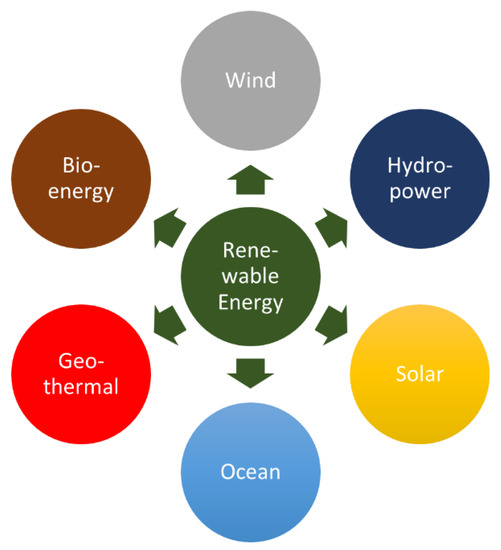
Figure 1.
Types of renewable energy. Source: own study based on [11].
Renewable energy sources have two important functions in sustainable transitions: they create new nature-provided capital, and at the same time, they significantly reduce greenhouse emissions and contribute to restoring the planet’s assimilation capacity [12]. Renewable energy sources provide electric energy and heat. A technological challenge remains regarding energy storage and proliferation [13]. The proliferation of renewable energy generation sources and micro-grid distribution systems allows operators to supply aggregated loads by electricity purchases from a transmission grid or from a locally generated renewable energy source (e.g., solar, photovoltaic, or wind). Renewable energy resources and technologies are the key components of sustainable development for three main reasons [14]:
1. They have a lower environmental impact than other energy sources. The multiplicity of renewable energy resources allows a diverse range of application.
2. They are not depletable. Renewable energy sources, when employed correctly in appropriate applications, can provide a steady and sustainable supply of energy.
3. They support system decentralisation and local solutions that are relatively independent of the national network, so increasing system flexibility and offering economic benefits to isolated communities. Furthermore, the small scale of the equipment frequently decreases the time necessary from initial design to operation, allowing for greater versatility in responding to unforeseen growth and/or changes in energy demand.
Energy transition is part of a wider process called sustainable transition [15,16]. According to McIntosh [17], there are many transitions taking place simultaneously: a move from high-emission economy to low-emission economy, from social inequality to egalitarianism, from everyday practice of breaching human rights to socially fair societies. Ropke draws attention to the fact that there are many areas requiring change, including such systems as production, consumption, energy distribution, transport, and agriculture [18].
For years, it was assumed that economic stability may be based on the economic growth concept. However, this approach favoured the growing consumption of natural resources and energy.
At the same time, the production of waste and the greenhouse effects kept growing. Ryszawska emphasises that such economies generate a vicious circle of interdependencies, as production growth causes consumption growth, and the latter in effect leads to the growing use of natural resources and higher emissions [19]. The ambitious goal of sustainable transition requires a move from brown economy to green economy (Figure 2). The energy transition must be regarded as part of a wider process of sustainable transition. It is essential to view changes in renewable energy use in a broader context and to integrate them into other efforts for sustainable development.
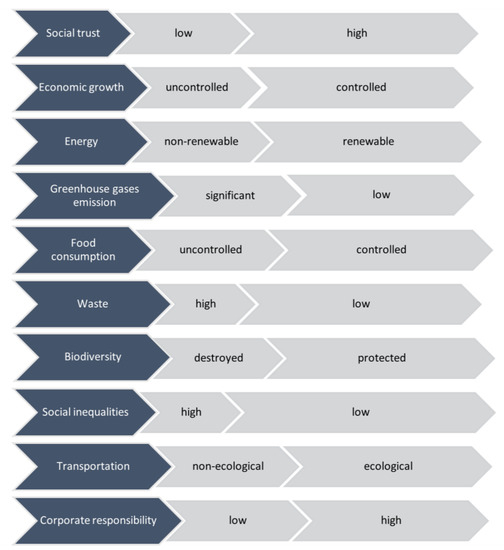
Figure 2.
The key elements of transition from brown to green economy. Source: own study based on [19].
Loorbach underlines that energy transition requires new alternative approaches [20] appraising visions and concepts as well as stimulating participatory–deliberative processes to move the collective and political nature of transitions forward [21].
Significant factors favouring energy transition include the following [14]:
1. The establishment of renewable energy markets;
2. Experience with renewable technologies;
3. The removal of barriers and constraints to the diffusion of renewable energy;
4. The establishment of a legal, administrative, and financing infrastructure to facilitate planning and implementing renewable energy projects;
5. The promotion of renewable energy technologies by initiating surveys and studies to establish their potential at the local and regional levels.
A system interpretation of the transition process is presented by Geels [22]. He describes how transitions in socio-technical systems can be understood as reconfigurations of dynamically stable socio-technical regimes within these systems. These regimes represent the prevailing configuration of existing technologies, scientific fields, incumbent industrial actors, and institutional structures. Regime reconfigurations emerge through the interaction of three elements (Figure 3):
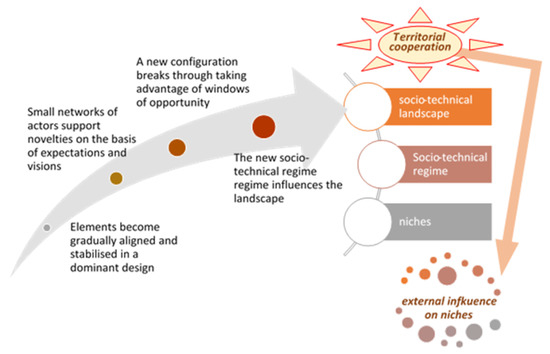
Figure 3.
Territorial cooperation as the potential stimulator of sustainable transition. Source: own study based on [22].
- Niches;
- Socio-technical regimes (the locus of established practices and associated rules that stabilise existing systems);
- Socio-technical landscape.
Niches usually refer to research and development laboratories where entrepreneurs, inventors, and other actors strive for radical innovations. Usually, these activities are stimulated by subsidised projects. Socio-technical regimes mean a platform of established practices and associated rules that stabilise existing systems. The socio-technical landscape shapes transitions through physical and geographical factors that cannot be affected by regime actors or niche factors.
Numerous external factors may have an impact on niche development, including international cooperation stimulating energy transition [23,24,25,26]. Territorial cooperation [27] is a special case of international cooperation involving sub-state bodies (e.g., local administration, NGOs, research institutes). Such collaboration may stimulate sustainability transition.
In the European Union, territorial collaboration finds financial support in the Cohesion Fund and neighbourhood policies supporting international projects [28] contributing to the energy transition of towns, cities, and regions [29]. The European Commission underlines that regional and local authorities often set more ambitious renewable targets that exceed national targets [30]. Concurrently, the Commission successively improves the instruments of territorial cooperation [31] to support investments for energy efficiency in sustainable renewable energy and in intelligent energy systems. A need arises to evaluate both the present condition and the development trends to show the directions of territorial cooperation development.
2. Goals and Methodology
The goal of the article was to answer the question of whether territorial cooperation contributes to BSR energy transition, and if so, in what way. The goal has been achieved by applying the system analysis methodology. System in the broadest sense means a set of interacting units with relationships among them [32,33]. The concept of the system has been used in social sciences for many years, as it enables a holistic view of the analysed phenomenon or process [34]. System analysis became a problem-solving process that breaks a system down into its component parts in order to study how well those component parts work and interact to achieve its goals [35]. This method seems to be one of the crucial inventions without which effective management in any field of human life, including socio-economic management, would be inconceivable [36]. System analysis has its limitations because it is the researcher who subjectively identifies elements of the system and interprets the relationships that occur between them.
The research model designed for the purpose of this article assumed three stages of analysis:
1. Analysis of the territorial cooperation landscape in scope of BSR energy transition;
2. Analysis of the territorial cooperation organisation in scope of BSR energy transition;
3. Analysis of the territorial cooperation effects in the scope of BSR energy transition.
Three sub-systems were the subject of analysis: The Baltic Sea Region as a transnational area, territorial collaboration as a form of international cooperation, and energy transition as an element of sustainable transition (Figure 4).

Figure 4.
Research model. Source: own study.
Literature studies were conducted and data acquired to identify the attributes of energy transition. Empirical research relied on secondary sources, including the European Union (EU) regulations, The International Renewable Energy Agency (IRENA) statistics, the EU Strategy for the Baltic Sea Region, and related documents. The key role in the conducted research can be attributed to the EU projects database (keep.eu), which helped to identify the completed 2016–2020 programmes and projects supporting the BSR energy transition. Project analysis shows the quantitative and qualitative results of cooperation.
3. The BSR Territorial Cooperation Landscape
The Baltic Sea Region is defined and delimited in various ways. In the narrow meaning, it covers eight Baltic states, i.e., Denmark, Sweden, Finland, Russia (northern regions), Estonia, Latvia, Poland, and Germany (northern regions). In the wider meaning, the region embraces also countries of the Baltic Sea catchment area: that is, Norway and Belarus [37]. International cooperation lasted many years in the Baltic Sea Region [38,39] underwent dynamic acceleration with Poland and the Baltic States joining the European Union in 2004. Soon, the Baltic Sea region stood apart from other transnational regions, including EU macroregions, because of the high level of cooperation between local, regional, and national authorities. The BSR states, cooperating within the Council of the Baltic Sea States, were the initiators of the Baltic integration at the end of the twentieth century. Cities and regions have increased their activities throughout time, and they have also developed networking organisations. In such conditions, multi-level collaboration in the Baltic Sea region was required to be coordinated. This was made feasible in large part by an EU initiative in which the Baltic Sea Region’s countries agreed to establish and implement a macro-regional strategy, namely the EU Strategy for the Baltic Sea Region [40]. The primary objective of the strategy was to save the Baltic Sea, to connect and to augment the prosperity of the region. Renewable energy development improves all these areas and is the key factor in implementing EU energy policy priorities [41]. The first Action Plan of EUSBSR emphasised renewable energy problems [42].
One of the strategy tasks was to reduce disparities in using renewable energy sources in BSR. The study of BSR usage of renewable energy in the years 2010–2019 (Figure 5) showed that the region presented positive results compared to the entire EU [43]. Nevertheless, the region included states that managed well the use of renewable energy (Norway, Sweden) and others (Germany, Poland) that considerably lowered the average.
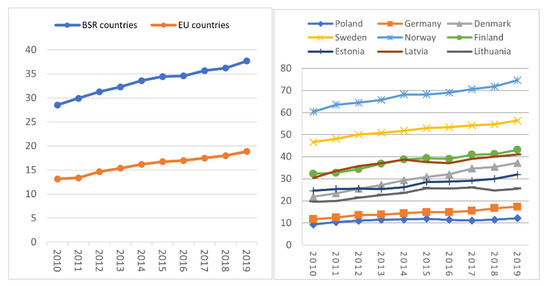
Figure 5.
The share of renewable energy in total energy generation in EU, BSR, and particular BSR states (2010–2019) [%]. Source: own study based on [43].
The relations between energy efficiency and renewable energy use are also worthy of attention (Figure 6). Countries enjoying the greatest energy efficiency (Norway, Sweden) demonstrate the best renewable energy use indicators. Germany and Poland found themselves on the other end. In 2014, the mean energy efficiency indicator in BSR read 71.97% with the mean energy efficiency use indicator of 33.55%. German indicators read 38.3% and 14.38%, respectively, and Poland showed 30.1% and 11.6%, respectively. Scientists studying energy issues agree that the development of renewable energy requires not only resigning from non-renewable energy but also “creating sustainable energy development and supporting cooperation” [44].
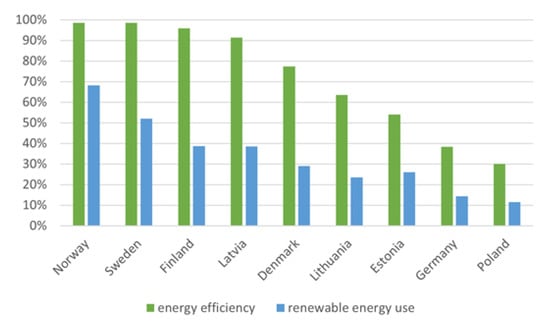
Figure 6.
Energy efficiency and renewable energy use in BSR in 2014. Source: own study based [44].
The use of particular types of energy in BSR states is diversified (Table 1). Renewable power generation capacity is measured as the maximum net generating capacity of power plants and other installations that use renewable energy sources to produce electricity [45].

Table 1.
Renewable energy capacity in BSR states in 2011 and 2020 (MW).
Comparing the structure of renewable energy capacity in BSR countries in the years 2011 and 2020 (Figure 7), we can note the dominant position of hydropower energy. However, the use of wind energy and solar energy showed a percentage growth.

Figure 7.
The structure of renewable capacity in BSR countries in 2011 and 2020. Source: own study based [46].
The summary of the renewable energy capacity in EU member states of BSR in 2011 and 2020 is interesting (Figure 8). Analysing the above data, we note a spectacular 132% increase in wind energy capacity. The share of wind energy in the structure of renewable energy capacity increased from 28% to 43%, and wind energy became the leading source of renewable energy.
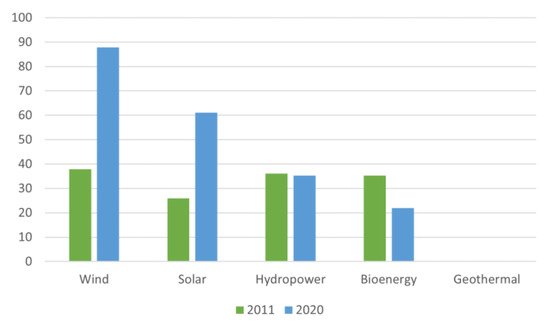
Figure 8.
Renewable energy capacity in EU Member States of BSR in 2011 and 2020 [GW]. Source: own study based on [46].
In the political and scientific discussions on how the Baltic Sea Region contributes to the sustainable transition of the energy sector, the development of offshore wind potential is considered a crucial element [47]. The awareness of the existing vast potential as well as economic, energy, and environmental benefits of investment has led to more intense recent cooperation of stakeholders on these issues.
The development of energy collaboration requires grid ‘connections’ among countries around the Baltic (Figure 9). Up to date, three different synchronic grids operate in the BSR:
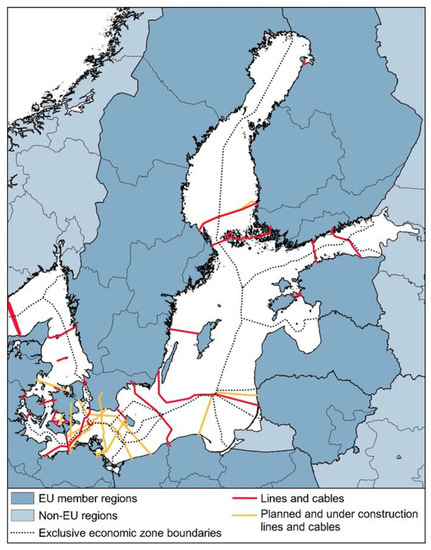
Figure 9.
Present and planned energy cables and lines connecting BSR countries. Source: own study.
- Nordic (Finland, Sweden, Norway);
- Baltic (Lithuania, Latvia, Estonia);
- Continental (Denmark, Germany, Poland).
The BSR faces the challenge of developing a concept for integrating these grids, which would involve, inter alia, the construction of cross-border transmission capacity infrastructure. The connections between Poland and Sweden completed in the year 2000 and those between Estonia and Finland (2007) started a new era in mutual connections. Successive underwater cable connections are at the designing phase and investment preparations.
4. Organisation of Territorial Cooperation in BSR Energy Transition in the Period 2014–2020
The development of territorial cooperation within BSR was financially supported by the EU cohesion policy instrument called the European Territorial Cooperation (ETC). The cohesion policy followed the provisions of the Treaty on the Functioning of the European Union, which committed EU bodies to undertake measures to enhance economic, social, and territorial cohesion and reduce disparities between the levels of development of the various EU regions [48]. The European Structural and Investment Funds were established to finance these measures. One of the funds—the European Regional Development Fund—ensured financial means for ETC. Three types of territorial cooperation were identified [49]:
1. Cross-border cooperation between regions divided by the state border;
2. Transnational cooperation covering a larger area on the territory of at least two countries;
3. Interregional cooperation involving regions in different parts of the world.
In the years 2014–2020, 14 ETC programs functioned in the BSR: 1 international, 1 transnational, and 12 cross-border programmes (Figure 10).
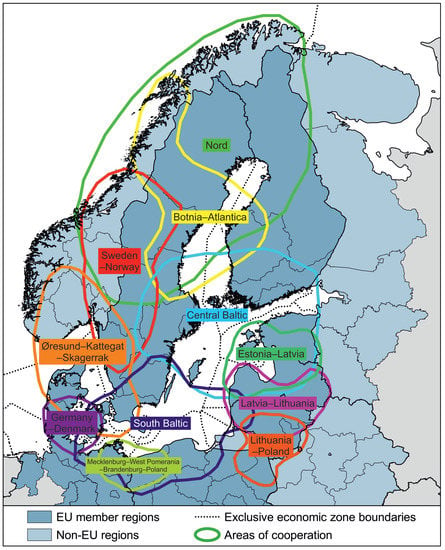
Figure 10.
Map of BSR cross-border programmes in 2014–2020. Source: own study based on [50].
Each of the ETC programmes provided a different option for energy transition undertakings. This variation stemmed from the programmes’ architecture and relations between determinants of cooperation such as specific objectives, investment priorities, and intervention priorities (Figure 11).
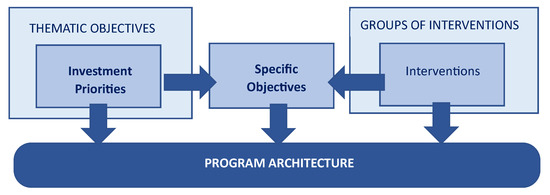
Figure 11.
ETC programmes architecture. Source: own study.
Thematic objectives for EU programmes were defined in line with Agenda 2020 priorities [51] supporting smart, sustainable, and inclusive growth. The European Commission set 11 Thematic Objectives (TO) in ETC programmes for the period 2014–2020 [52] based on three priorities of Agenda 2020 (Figure 12).
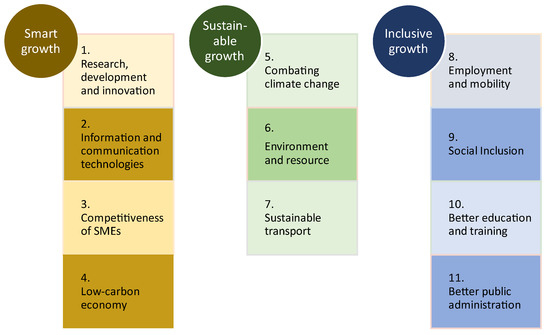
Figure 12.
Thematic objectives of ETC programmes 2014–2020. Source: own study based on [52].
The 11 TOs comprised 38 investment priorities. Issues directly related to energy were included in three (IP) under Low-carbon economy TO 4 and one IP part of TO 7 Sustainable transport.
- (IP 4a) Promoting the production and distribution of energy derived from renewable sources;
- (IP 4b) Promoting energy efficiency and renewable energy use in enterprises;
- (IP 4c) Supporting energy efficiency, smart energy management, and renewable energy use in public infrastructure, including in public buildings and in the housing sector;
- (IP 7 c) Improving energy efficiency and security of supply through the development of smart energy distribution, storage, and transmission systems and through the integration of distributed generation from renewable sources.
The European Commission recognised the significance of renewable energy in territorial cooperation so that instructions appeared in ETC programmes on how to proceed with renewable energy projects in the remaining TOs. This step facilitated studies on renewable energy (under TO 1), adaptation of ecosystems applying renewable energy (under TO 6) and supporting the renewable energy sector (under TO 3). For measures funded by the ERDF, nine groups of Interventions (Figure 13) were identified comprising in total 123 Interventions.
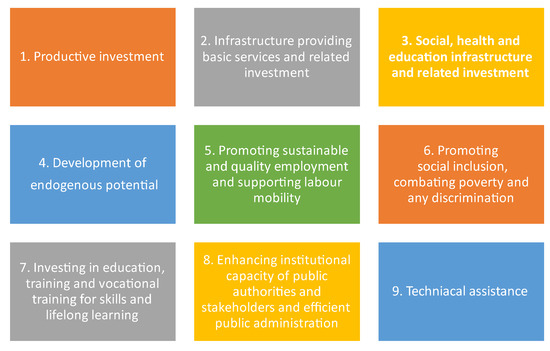
Figure 13.
Groups of Interventions in European Regional Development Fund. Source: own study based on [52].
Intervention group number 2 identified the strand Energy Infrastructure (Figure 14) comprising 16 Interventions including four related to renewable energy: wind energy, solar energy, biomass energy, and others. The last category embraced hydroelectric, geothermal, and marine energy and renewable energy integration including storage, power to gas, and renewable hydrogen infrastructure.
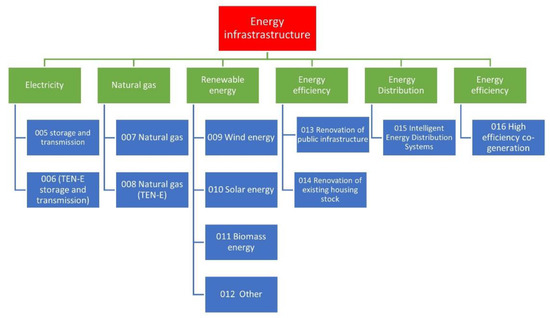
Figure 14.
Interventions related to energy in ETC programmes in the period 2014–2020 under the Energy Infrastructure strand. Source: own study based on [52].
Thematic Objectives, Investment Priorities related to energy, as well as Interventions and Specific Objectives in ETC programmes for BST in the period 2012–2020 are presented in Table 2.

Table 2.
Thematic Objectives, Investment Priorities related to energy, as well as Interventions and Specific Objectives in ETC programmes for BST in the period 2012–2020.
Investment Priorities related to energy appeared only in one ETC programme; nevertheless, energy-related Interventions appear in three programmes, whereas energy Specific Objectives appear in four programmes. The analysis of particular programmes indicates that in their majority (except for two programmes), they contain provisions connected with energy. Some programmes (inter alia, transnational Baltic Sea programmes) treat energy issues as a priority (Table 3).

Table 3.
Energy issues in ETC programmes for BSR in the period 2014–2020.
5. Territorial Cooperation Effects in BSR Energy Transition—Quantitative Analysis
Territorial cooperation in the BSR concerning renewable energy in the years 2014–2020 involved joint projects funded by 14 financial programmes of the EU Cohesion Fund Policy (Table 4). Within the framework of these programmes, 1471 projects were carried out in total. The joint number of projects, including energy Investment Priorities (IP 4a and IP 4c), numbered 21. According to the keep.eu database, 40 projects were completed under the Theme Renewable energy, and 58 projects were completed under the Theme Energy efficiency. The term ‘energy’ in the description was found in 186 projects. Projects selected according to the criteria given above were studied in detail, which allowed for the final identification of 137 energy projects. The number of energy projects in particular programmes ranged from 1 to 34, whereas the percentage share of energy projects oscillated between 0.76% and 24.14%.

Table 4.
Energy in ETC programmes for BSR in the period 2014–2020.
5.1. Projects of the Interregional Programme
The interregional cooperation programme INTRREG Europe 2014–2020 is a programme covering Europe. BSR is only part of Europe. Entities from the entire area of Europe were partners in 250 projects. Only those projects that included at least two BSR entities were further analysed. From amongst these projects, 34 energy projects were chosen.
5.2. Projects of Transnational Programme
The transnational cooperation programme Baltic Sea completed 181 projects. Thirty-six projects contained the term energy. The keep.eu database allocated seven projects to the Theme Renewable Energy and 13 projects to Energy Efficiency. Verification of the project descriptions revealed 23 energy projects.
5.3. Projects of the Cross-Border Programmes
Within the framework of twelve cross-border cooperation projects, 1040 were completed, including 80 energy projects. The greatest number of projects (21) was completed in the programme Sweden–Denmark–Norway (Öresund–Kattegat–Skagerrak). This was the only programme with energy Investment Priorities. The fewest number of projects (one each) was completed in the cross-border areas of Lithuania and Poland, Lithuania and Latvia, and Poland and the German Land Saxony. The keep.eu database assigned 23 projects to the theme Renewable Energy, whereas 32 projects were assigned to Energy Efficiency.
5.4. The Subject Range of Territorial Cooperation
The quantitative study of 137 projects identified nine subject categories (Table 5) including five renewable energy categories: wind, biological, thermal, solar, and water energy. Among the 37 energy projects in the range of specified sources of renewable energy, the greatest number (15) concerned biological energy and the fewest (2) concerned thermal energy. A very popular cooperation category was energy efficiency (53 projects) and energy transition (42 projects).

Table 5.
Classification of energy transition projects according to subject range in BSR.
6. Territorial Cooperation Effects in BSR Energy Transition—Qualitative Analysis
6.1. Use of Wind Energy
The development of wind energy in SUERMB was recognised as a priority of energy transition in the region and is reflected in the concluded projects. The project Integrated Baltic offshore wind electricity grid development, financed by INTERREG Baltic Sea, created the Baltic Offshore Grid Forum cooperation platform gathering key wind energy stakeholders. These included transmission system operators, offshore wind energy industry, policymakers, national authorities, and academics. Studies were conducted that produced a diagnosis of the present situation and indicated wind energy cooperation scenarios in the BSR. Four scenarios were adopted (Figure 15):
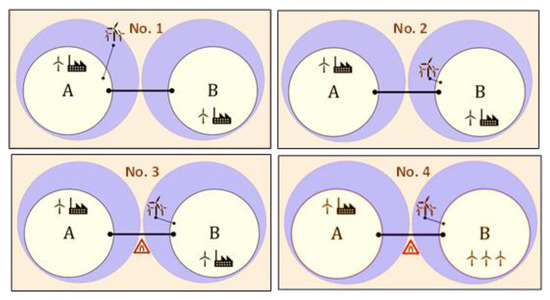
Figure 15.
Scenarios of cross-border cooperation in wind energy. Source [67].
- Wind farm built in domestic territory (baseline option);
- No cross-border restrictions;
- Limited interconnection capacity, identical generation fleets;
- Limited interconnection capacity, different generation fleets.
Additionally, a vision of developing wind energy was elaborated to the year 2050 (Figure 16). Current proposals for offshore wind farms and interconnections suggest that the key component of the 2050 vision could be a combination of the southwest and southeast meshed grid systems. Wind farms close to the shore would be expected to be connected radially, whereas wind farms further from the shore would be expected to be connected via the integrated grid. As a secondary emphasis, Estonia, Finland, and Sweden would be considered in the northern half of the Baltic Sea. The agenda also projects a third priority: connecting the northern and southern systems via a setup off the Baltic Sea coastlines. To achieve the set goals, a list of recommendations was worked out regarding the policies, regulations, and maritime spatial planning. The Baltic Lines project [68] allowed marine spatial planners in Baltic Sea countries to coordinate their national plans for developing energy corridors with shipping routes, hence improving connectivity throughout the Baltic Sea. Cooperation along the Danish and German border resulted in innovative projects for household wind farms.
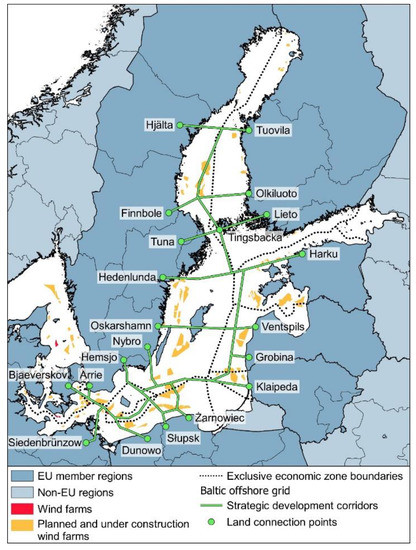
Figure 16.
Baltic Offshore Grid (BOG 2050) concept. Source: own study based on [67].
6.2. Use of Water Energy
Water energy issues appear in three cross-border projects. A project on the border of Lithuania and Latvia resulted in identifying inadequate water flow in lower water energy plants and in assessing the ecoflow [69]. Recommendations were put forward to review the national water law, which affected the strategic planning of water use and the issue of permits. In Scandinavia, cross-border projects promoted water plants as a cultural heritage attraction [70].
6.3. Use of Geothermal Energy
Two projects were dedicated to geothermal energy. Within the transnational project Baltic Sea Underground Innovation Network, a network of underground laboratories was established for the transfer of scientific technologies and exchange of good practices (Figure 17).
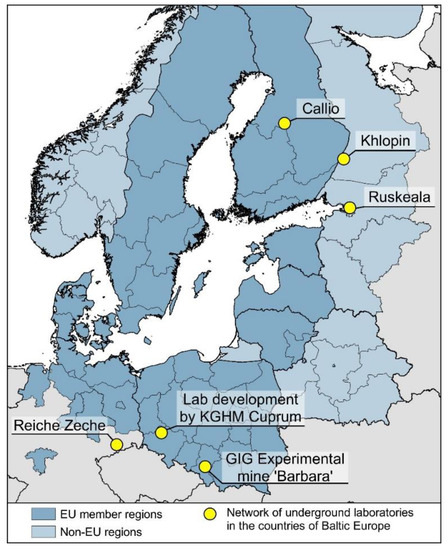
Figure 17.
Network of underground laboratories. Source: own study based on [71].
Abandoned mines were adapted to conduct studies on geothermal energy [71]. A method for measuring the thermal neutron stream [72] was developed. The European Underground Laboratories Association (EUL) was established to promote research, technology development, innovation, education, and events organised in underground laboratories [73]. Furthermore, methods for heating buildings with geothermal energy were implemented.
6.4. Use of Bioenergy
BSR benefited from 16 bioenergy projects, including an ambitious project of establishing an international consortium for improving the effective and sustainable use of biomass to produce energy [74]. The developed GIS platform presented the potential of forest biomass in specified BSR geographical areas [75]. Work started on developing an atlas of forest energy (Figure 18).
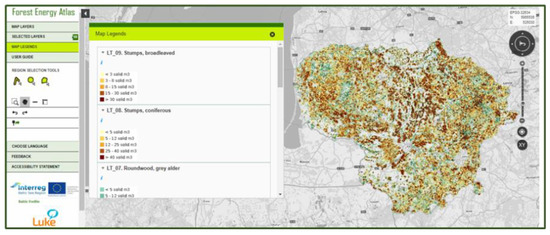
Figure 18.
Forest Energy Atlas (presenting data for Lithuania). Source: [76].
A plan for the development of small bioenergy power stations was developed for rural areas of the Baltic Sea Region. Actions were undertaken to develop regional bioenergy policies [77]. Territorial cooperation for the development of bioenergy covered, inter alia, such issues as the use of sewage, energy plants, and waste. The Biogas 2020 project [78] initiated measures to make Scandinavia the leader of sustainable production and use of biogas.
6.5. Use of Solar Energy
The cross-border programme Central Baltic financed four projects that contributed to the use of solar energy in coastal harbours. The ports of Finland started featuring innovative solar panels [79]. The project Energetic Small Ports in the Central Baltic Region [80] played an important role in the development of a cooperation network embracing ports implementing investments and other ports interested in cooperation (Figure 19).
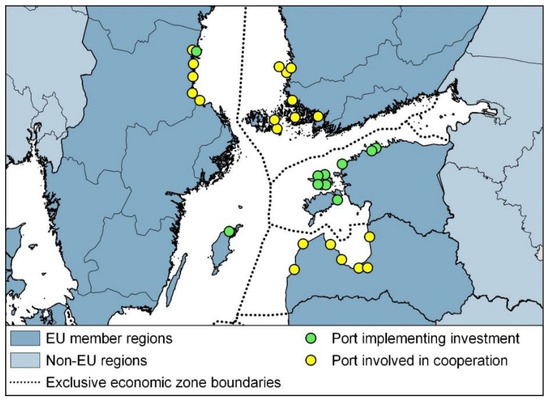
Figure 19.
Energetic small ports in the central Baltic region cooperation network. Source: own study based on [80].
6.6. Using Renewable Energy in the Development of Transport
Six projects conducted within the programme of interregional cooperation INTERREG Europe facilitated the exchange of good practices in the development of local transport development using renewable energy (RE). In the cross-border area of Sweden and Norway [81] as well as Sweden and Denmark, the local transport projects were based on hydrogen fuel. The project goal was to reject fossil fuel in the development of local public transport [82].
6.7. Energy Storage
Five projects were completed within the cross-border programmes devoted to improving methods of energy storage. The projects involved, inter alia, the circular industrial symbiosis model, which assumed the storage of energy generated by waste [83] and rules of storing energy in buildings [84]. The developed Vehicle-to-Grid (V2G) concept assumed the use of electric vehicles as sources for energy storage. The concept was tested in the northern areas of the BSR [85].
6.8. Energy Effectiveness
Work on improving energy effectiveness in the BSR was conducted in 53 projects financed by 10 ETC programmes. The project Effective Financing Tools for implementing Energy-Efficient Buildings gained the status of the EUSBSR flag project. Measures were undertaken at the local level to improve the effectiveness of buildings by promoting innovations [86], the development of energy monitoring [87], and the support of public orders supporting energy saving [88]. Territorial cooperation supported a number of various enterprises devoted to energy saving in transport, heating systems, lighting systems, data centres, sport facilities, agricultural infrastructure, and sewage plants. The established forum of science and implementation institutions of the Baltic Science Network supported innovative solutions for energy effectiveness [89].
6.9. Energy Transition
Territorial cooperation in energy transition embraced 48 projects, which had a significant educational dimension. The key partners gathered mainly business, self-governmental authorities, and local societies. A number of local energy transitions strategies were developed. The developed recommendations for improving spatial planning for renewable energies in the Baltic Sea Region [90] contributed significantly to energy transition. The value chain for transnational renewable energy projects (Figure 20) presented directions of further cooperation.
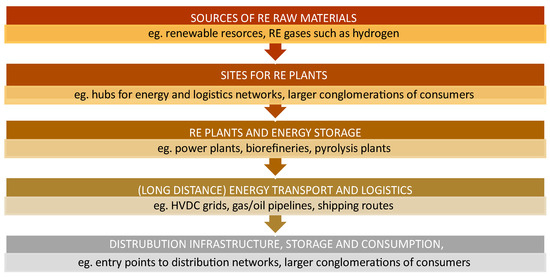
Figure 20.
Value chain for transnational renewable energy projects. Source: own study based on [90].
It has been agreed to extend spatial planning for renewable energies to include spatially relevant aspects of large-scale production and logistics of renewable energy raw materials. Consecutive stages were projected, indicating the locations of plants, development of plant concepts and energy storage, and long-distance energy transport and logistics. The last element is the development of distribution infrastructure, storage, and consumption. Four levels of cooperation were specified with assigned key projects (Figure 21).
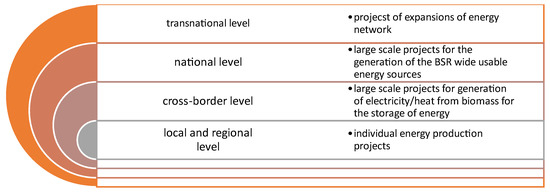
Figure 21.
Cooperation level and energy transition projects. Source: own study based on [90].
Territorial cooperation resulted in developing a number of local energy transition programmes. Renewable energy became part of numerous strategies for the intelligent specialisation of some Baltic regions [91]. Instruments were developed encouraging the use of RE in production in municipal and rural areas. BSR initiated cross-border clusters of clean energy [92] and cooperative partnerships for renewable energy supporting community energy project development [93].
7. Conclusions
The conducted study proves that territorial cooperation contributes to energy transition in the Baltic Sea Region primarily thanks to the financial support of the EU cohesion Fund in conducting joint projects. The spatial dimension and cooperation effects depend on the territorial cooperation priorities and programme goals. The programmes supported energy transition in various ways. Some cross-border projects bypassed energy issues completely, while others marked them as a priority. The projects completed within the framework of the programmes covered all types of renewable energy accounted for in the IRENA statistics. The only exception in the BSR was ocean energy. The majority of projects focused on the development of bioenergy. Nevertheless, it worth noting that in the years 2011 to 2020, the interest in this type of renewable energy showed a falling trend in EU BSR countries. However, the period featured a spectacular rise of interest in wind energy. Cross-border cooperation followed this trend and specified further priorities and scenarios for the development of wind farms. The project Baltic InteGrid: towards a meshed offshore grid in the Baltic Sea became of special importance for energy transition. It showed a common energy grid for the entire region.
The specificity of the territorial cooperation projects was their minor budget, which created limited options for investments. Territorial cooperation contributed to the development of a collaboration network and in effect to the promotion of good practices in energy transition. BSR involvement in renewable energy, in the saving of energy, and in improving energy efficiency brings the region closer to the vision of a leader in the sustainable development in Europe.
The system analysis method was employed in our study. The limitations of this method originate from the fact that the researchers were the ones who identified the system’s components and interpreted the relationships between them. Only territorial cooperation in the narrow sense as a goal of the European Union’s cohesion policy was investigated. The qualitative analysis of the projects posed a significant problem due to the usage of a database in which the projects were presented in a variety of ways. We were unable to complete the whole project documentation due to time and financial constraints. In our opinion, research concerning the long-term effects of completed projects is necessary. Furthermore, future research could focus on the topic of territorial cooperation coordination within the EUSBSR. This is significant because one of the priority topics in the strategy’s governance system is energy. However, we believe we have developed an essential diagnosis that policymakers might employ in their subsequent follow-up.
Author Contributions
Conceptualisation, T.S.; methodology, T.S. and T.P.; software, T.S. and T.P.; validation, T.S. and T.P.; formal analysis, T.S., R.J. and T.P.; investigation, T.S., R.J. and T.P.; resources, T.S., R.J. and T.P.; data curation, T.S. and T.P.; writing—original draft preparation, T.S. and T.P.; writing—review and editing, T.S. and T.P.; visualisation, T.S. and T.P. supervision, T.S.; funding acquisition, T.S. and T.P. All authors have read and agreed to the published version of the manuscript.
Funding
This research was funded by GDYNIA MARITIME UNIVERSITY, grant number WZNJ/2021/PZ/09.
Institutional Review Board Statement
Not applicable.
Informed Consent Statement
Not applicable.
Data Availability Statement
Not applicable.
Conflicts of Interest
The authors declare no conflict of interest. The funders had no role in the design of the study; in the collection, analyses, or interpretation of data; in the writing of the manuscript, or in the decision to publish the results.
References
- Schlaile, M.P.; Urmetzer, S. Transitions to sustainable development. In Encyclopedia of the UN Sustainable Development Goals: Decent Work and Economic Growth; Leal Filho, W., Azul, A.M., Bandli, L., Özuyar, P.G., Wall, T., Eds.; Springer: Cham, Switzerland, 2019. [Google Scholar]
- Jackson, T. Prosperity without Growth. Economics for Finite Planet; Earthscan: London, UK, 2009. [Google Scholar]
- Afonso, T.L.; Marques, A.C.; Fuinhas, J.A. Does energy efficiency and trade openness matter for energy transition? Empirical evidence for countries in the Organization for Economic Co-operation and Development. Environ. Dev. Sustain. 2021, 23, 13569–13589. [Google Scholar] [CrossRef]
- Koch-Orvad, N.; Thuesen, C. Sustainable Building in Scandinavia: Directions of Innovations for Supporting the Transition. In Proceedings of the 32nd Annual ARCOM Conference, Manchester, UK, 5–7 September 2016; Chan, P.W., Neilson, C.J., Eds.; Association of Researchers in Construction Management: Manchester, UK, 2016; Volume 2, pp. 1159–1167. [Google Scholar]
- Berkhout, F.; Marcotullio, P.; Hanaoka, T. Understanding energy transitions. Sustain. Sci. 2012, 7, 109–111. [Google Scholar] [CrossRef] [Green Version]
- Berkhout, F.; Angel, D.; Wieczorek, A.J. Asian development pathways and sustainable socio-technical regimes. Technol. Forecast. Soc. Chang. 2009, 76, 218–228. [Google Scholar] [CrossRef]
- Gaziulusoy, A.I.; Brezet, H. Design for system innovations and transitions: A conceptual framework integrating insights from sustainability science and theories of system innovations and transitions. J. Clean. Prod. 2015, 108, 558–568. [Google Scholar] [CrossRef]
- Coenen, L.; Hansen, T.; Glasmeier, A.; Hassink, R. Regional foundations of energy transitions. Camb. J. Reg. Econ. Soc. 2021, 14, 219–233. [Google Scholar] [CrossRef]
- Lowitzsch, J. Energy Transition: Financing Consumer Co-Ownership in Renewables; Palgrave Macmillan: Cham, Switzerland, 2019. [Google Scholar]
- Twidell, J. Renewable Energy Sources; Taylor and Francis: Abingdon, UK, 2015. [Google Scholar]
- The International Renewable Energy Agency. Available online: https://www.irena.org (accessed on 24 September 2021).
- Bielek, B. New classification of renewable energy sources in the development of technology in architecture for a sustainable society. Tech. Trans. Civ. Eng. 2014, 3-B, 41–47. [Google Scholar]
- Zhou, Q.; Shahidehpour, M.; Sun, T.; Feng, D.; Yan, M. Cooperative Game for Carbon Obligation Allocation Among Distribution System Operators to Incentivize the Proliferation of Renewable Energy. IEEE Trans. Smart Grid 2019, 10, 6355–6365. [Google Scholar] [CrossRef]
- Dincer, I.; Rosen, M.A. Exergy, Environment And Sustainable Development. In Exergy, 2nd ed.; Elsevier: Amsterdam, The Netherlands, 2013; pp. 51–73. [Google Scholar]
- Ceschin, F.; Gaziulusoy, I. Evolution of design for sustainability: From product design to design for system innovations and transitions. Des. Stud. 2016, 47, 118–163. [Google Scholar] [CrossRef]
- Włodarczyk, B.; Firoiu, D.; Ionescu, G.H.; Ghiocel, F.; Szturo, M.; Markowski, L. Assessing the Sustainable Development and Renewable Energy Sources Relationship in EU Countries. Energies 2021, 14, 2323. [Google Scholar] [CrossRef]
- McIntosh, M. The Necessary Transition. In The Journey towards the Sustainable Enterprise Economy; Greenleaf Publishing: London, UK, 2013. [Google Scholar]
- Ropke, I. Sustainability transitions in the perspective of ecological macroeconomics. In Proceedings of the 10th Biennial Conference of the European Society for Ecological Economics, Lille, France, 18–21 June 2013; European Society for Ecological Economics (ESEE): Lille, France, 2013. [Google Scholar]
- Ryszawska, B. Zielona transformacja gospodarki jako droga do gospodarki umiaru. In Ekonomia Umiaru—Realna Perspektywa? Nowy Paradygmat Grzegorza W. Kołodko; Pach, J., Kowalska, K., Szyja, P., Eds.; PWN: Warszawa, Poland, 2016. [Google Scholar]
- Loorbach, D. Transition management for sustainable development: A prescriptive, complexity-based governance framework. Governance 2010, 23, 161–183. [Google Scholar] [CrossRef]
- Gaziulusoy, İ.; Erdoğan Öztekin, E. Design for Sustainability Transitions: Origins, Attitudes and Future Directions. Sustainability 2019, 11, 3601. [Google Scholar] [CrossRef] [Green Version]
- Geels, F.W. Technological transitions as evolutionary reconfiguration processes: A multi-level perspective and a case-study. Res. Policy 2002, 31, 1257–1274. [Google Scholar] [CrossRef] [Green Version]
- China’s Energy Revolution in the Context of the Global Energy Transition; Springer Nature: Cham, Switzerland, 2020.
- Hafner, M.; Tagliapietra, S. The Geopolitics of the Global Energy Transition; Springer Nature: Cham, Switzerland, 2020. [Google Scholar]
- Lumbreras, S.; Abdi, H.; Ramos, A. Transmission Expansion Planning: The Network Challenges of the Energy Transition; Springer Nature: Cham, Switzerland, 2021. [Google Scholar]
- Change Ahead? Sustainable Governance in the BRICS; Verlag Bertelsmann Stiftung: Gütersloh, Germany, 2013.
- Gorzelak, G.; Zawalinska, K. European Territories. From Cooperation to Integration; Scholar: Warsaw, Poland, 2013. [Google Scholar]
- Scott, J.W. European territorial cooperation: Theoretical and empirical approaches to the process and impacts of cross-border and transnational cooperation in Europe. Reg. Stud. 2020, 54, 140–141. [Google Scholar] [CrossRef]
- Prieto, J.G. Impact of European Territorial Cooperation (ETC) on the promotion and use of solar energy in the Mediterranean. Reg. Stud. Reg. Sci. 2016, 3, 185–192. [Google Scholar]
- Directive (EU) 2018/2001 of the European Parliament and of the Council of 11 December 2018 on the Promotion of the Use of Energy from Renewable Sources. Available online: https://eur-lex.europa.eu/legal-content/EN/TXT/?uri=uriserv:OJ.L_.2018.328.01.0082.01.ENG (accessed on 20 September 2021).
- Regulation (EU) 2021/1058 of the European Parliament and of the Council of 24 June 2021 on the European Regional Development Fund and on the Cohesion Fund. Available online: https://eur-lex.europa.eu/eli/reg/2021/1058 (accessed on 20 September 2021).
- Sieniutycz, S. Complexity and Complex Thermo-Economic Systems; Elsevier: Amsterdam, The Netherlands, 2020. [Google Scholar]
- Bertalanffy, L. General Systems Theory—Foundation, Development, Applications; Baziller Press: New York, NY, USA, 1968. [Google Scholar]
- Blalock, H.; Blalock, A. Toward a Clarification of System Analysis in the Social Sciences. Philos. Sci. 1959, 26, 84–92. [Google Scholar] [CrossRef]
- Martynyshyn, Y.; Khlystun, O.; Adamoniene, R.; Dibrova, V. System Analysis in Socio-Cultural Management: Theory, Methodology and Technology. Socio-Cult. Manag. 2020, 3, 3–29. [Google Scholar] [CrossRef]
- Checkland, P. Systems Thinking, Systems Practice; Wiley: Chichester, UK, 1999. [Google Scholar]
- Klemeshev, A.; Korneevets, V.; Palmowski, Т.; Studzieniecki, T.; Fedorov, G. Approaches to the definition of the Baltic Sea Region. Balt. Reg. 2017, 9, 4–20. [Google Scholar] [CrossRef]
- Kasekamp, A. A History of the Baltic States; Palgrave McMillan: New York, NY, USA, 2010. [Google Scholar]
- Studzieniecki, T.; Przybyłowski, A. Multilevel governance issues in EU macroregions. In Proceedings of the 6th Central European Conference in Regional Science Engines of Urban and Regional Development, Banska Bystrica, Slovakia, 20–22 September 2017; pp. 486–494. [Google Scholar]
- Palmowski, T. The European Union Strategy for the Baltic Sea Region and accomplishments. Balt. Reg. 2021, 13, 138–152. [Google Scholar] [CrossRef]
- Siksnelyte, I.; Zavadska, E.K.; Bausys, R.; Streimikiene, D. Implementation of EU energy policy priorities in the Baltic Sea Region countries: Sustainability assessment based on neutrosophic MULTIMOORA method. Energy Policy 2019, 125, 90–102. [Google Scholar] [CrossRef] [Green Version]
- Commission Staff Working Document Accompanying the Communication from The Commission to The European Parliament, The Council, The European Economic and Social Committee and the Committee of The Regions Concerning the European Union Strategy for the Baltic Sea Region ACTION PLAN (COM(2009) 248 Final). Available online: https://eur-lex.europa.eu/legal-content/EN/TXT/?uri=celex%3A52009DC0248 (accessed on 20 September 2021).
- EUROSTAT. Available online: https://ec.europa.eu/eurostat/statistics-explained/index.php?title=Renewable_energy_statistics (accessed on 1 October 2021).
- Hsiao, W.-L.; Hu, J.-L.; Hsiao, C.; Chang, M.-C. Energy Efficiency of the Baltic Sea Countries: An Application of Stochastic Frontier Analysis. Energies 2019, 12, 104. [Google Scholar] [CrossRef] [Green Version]
- IRENA. Available online: https://www.irena.org/publications/2021/March/Renewable-Capacity-Statistics-2021 (accessed on 1 October 2021).
- The International Renewable Energy Agency (IRENA). Renewable Energy Statistics 2021; The International Renewable Energy Agency (IRENA): Abu Dhabi, United Arab Emirates, 2021. [Google Scholar]
- Proninska, K.; Ksiezopolski, K. Baltic Offshore Wind Energy Development—Poland’s Public Policy Tools Analysis and the Geostrategic Implications. Energies 2021, 14, 4883. [Google Scholar] [CrossRef]
- Regulation (EU) No 1303/2013 of the European Parliament and of the Council of 17 December 2013 Laying down Common Provisions on the European Regional Development Fund, the European Social Fund, the Cohesion Fund, the European Agricultural Fund for Rural Development and the European Maritime and Fisheries Fund and Laying down General Provisions on the European Regional Development Fund, the European Social Fund, the Cohesion Fund and the and the European Maritime and Fisheries Fund and repealing Council Regulation (EC) No 1083/2006. Available online: https://eur-lex.europa.eu/legal-content/en/ALL/?uri=celex%3A32013R1303 (accessed on 20 September 2021).
- Regulation (EU) No 1299/2013 of the European Parliament and of the Council of 17 December 2013 on Specific Provisions for the Support from the European Regional Development Fund to the European Territorial Cooperation Goal. Available online: https://eur-lex.europa.eu/legal-content/EN/TXT/?uri=celex%3A32013R1299 (accessed on 20 September 2021).
- Interreg A—Cross-Border Cooperatio. Available online: https://ec.europa.eu/regional_policy/pl/policy/cooperation/european-territorial/cross-border/#4 (accessed on 15 September 2021).
- Europe 2020. A Strategy for Smart, Sustanable and Inclusive Growth. COM/2010/2020 Final. Available online: https://eur-lex.europa.eu/legal-content/EN/ALL/?uri=celex:52010DC2020 (accessed on 20 September 2021).
- European Structural and Investment Funds 2014–2020: Official Texts and Commentaries. Available online: https://ec.europa.eu/regional_policy/en/information/publications/legislation/2015/european-structural-and-investment-funds-2014-2020-official-texts-and-commentaries (accessed on 20 September 2021).
- INTERREG Europe 2014–2020. Available online: https://www.interregeurope.eu/fileadmin/user_upload/documents/Interreg_Europe_-_CP_final.pdf (accessed on 20 September 2021).
- Interreg Baltic Sea Region. Available online: https://www.interreg-baltic.eu/fileadmin/user_upload/about_programme/Main_documents/BSR_Cooperation_Programme.pdf (accessed on 20 September 2021).
- Interreg V-A Finland-Estonia-Latvia-Sweden (Central Baltic) Central Baltic Programme 2014–2020. Available online: http://centralbaltic.eu/sites/default/files/documents/Central%20Baltic%%20Document_2.pdf (accessed on 20 September 2021).
- Interreg V-A. PL-DK-DE-LT-SE—Poland-DenmarkGermany-Lithuania-Sweden (South Baltic). Available online: https://www.ewt.gov.pl/media/80690/Programme_2014TC16RFCB013_2_0_en.pdf (accessed on 20 September 2021).
- Interreg NORD 2014–2020. Available online: https://www.interregnord.com/ (accessed on 20 September 2021).
- Interreg V-A Sweden-Denmark-Norway (Öresund-Kattegat-Skagerrak). Available online: https://interreg-oks.eu/download/18.329faede16d1b2861c169030/1568711587872/Interreg%20%C3%96KS%20operativt%20program%20svenska%20dec%202014.pdf (accessed on 20 September 2021).
- Interreg V-A Sverige-Norge. Available online: http://www.interreg-sverige-norge.com/wp-content/uploads/2014/07/Programdokument-Interreg-V-A-Sverige-Norge1-1.pdf (accessed on 20 September 2021).
- Interreg V-A Lithuania-Poland. Available online: https://lietuva-polska.eu/en/interreg.html (accessed on 20 September 2021).
- Interreg V-A Latvia-Lithuania Cross Border Cooperation Programme 2014–2020. Available online: https://latlit.eu/wp-content/uploads/2016/02/Programme_2014TC16RFCB027_1_4_en.pdf (accessed on 20 September 2021).
- Interreg V-A. EE-LV—Estonia-Latvia. Available online: https://estlat.eu/assets/upload/About%20EstLat/Programme_2014TC16RFCB050_1_3_en_2015%2011%2020.pdf (accessed on 20 September 2021).
- Interreg V-A Deutschland-Dänemark. Available online: https://www.interreg5a.eu/wp-content/uploads/2016/09/Kooperationsprogramm_DE2.pdf (accessed on 20 September 2021).
- Program Współpracy INTERREG V A Brandenburgia—Polska 2014–2020. Available online: https://interregva-bb-pl.eu/wp%20content/uploads/2019/01/Program_Brandenburgia_Polska_2014_2020_PL.pdf (accessed on 20 September 2021).
- Program Współpracy Interreg V-A Niemcy/Meklemburgia-Pomorze Przednie/Brandenburgia—Polska. Available online: https://interreg5a.info/pl/component/edocman/programmdokumente/program-wspolpracy-interreg-v-a-meklemburgia-pomorze-przednie-brandenburgia-polska.html?Itemid (accessed on 20 September 2021).
- Program Współpracy INTERREG Polska—Saksonia 2014–2020. Available online: https://www.ewt.gov.pl/media/4148/Program_Wspolpracy_Interreg_Polska-Saksonia_2014-2020.pdf (accessed on 20 September 2021).
- Baltic InteGrid: Towards a Meshed Offshore Grid in the Baltic Sea; Final Report. Available online: https://projects.interreg-baltic.eu/fileadmin/user_upload/Library/Outputs/Baltic_InteGrid_HighLevelConcept.pdf (accessed on 20 September 2021).
- INTERREG Baltic Sea Region. Available online: https://projects.interreg-baltic.eu/projects/baltic-lines-29.html (accessed on 20 September 2021).
- INTERREG Litvija—Lietuva. Available online: https://latlit.eu/lli-249-ecoflow-ecological-flow-estimation-in-latvian-lithuanian-trans-boundary-river-basins/ (accessed on 20 September 2021).
- River Oulujoki Water System. Available online: http://vekuvaku.eu/river/river-oulujoki-water-system (accessed on 20 September 2021).
- BSUIN Project. Available online: http://bsuin.eu/wp-content/uploads/2021/01/WP-2.3-Geothermal-potential-WP2.3_f.pdf (accessed on 20 September 2021).
- The BSUIN Project—Overview and Same Results. Available online: https://www.researchgate.net/publication/331643521_The_BSUIN_project_-_overview_and_same_results (accessed on 20 September 2021).
- The European Underground Laboratories Association. Available online: https://undergroundlabs.network/about (accessed on 20 September 2021).
- Unlocking the Potential of Bio-Based Value Chains in the Baltic Sea Region. Available online: https://projects.interreg-baltic.eu/projects/balticbiomass4value-181.html (accessed on 20 September 2021).
- Accelerating Production of Forest Bioenergy in the Baltic Sea Region. Available online: https://www.luke.fi/en/projektit/baltic-forbio/ (accessed on 20 September 2021).
- Forest Energy Atlas. Available online: https://forest-energy-atlas.luke.fi (accessed on 20 September 2021).
- Sustainable Regional Bioenergy Policies: A Game Changer. Available online: https://www.interregeurope.eu/bio4eco/ (accessed on 20 September 2021).
- Biogs 2020. Available online: https://www.biogas2020.se (accessed on 20 September 2021).
- Small Ports Provide Improved Services in the Central Baltic Sea Region. Available online: https://www.utu.fi/en/news/news/small-ports-provide-improved-services-in-the-central-baltic-sea-region (accessed on 20 September 2021).
- Thing Link. Available online: https://www.thinglink.com/scene/1408416369053007875 (accessed on 20 September 2021).
- The Blue Move for Green Economy. Available online: https://interreg.no/prosjektbank/the-blue-move-for-green-economy (accessed on 20 September 2021).
- INTERREG Sverige-Norge. Available online: https://www.fossilfri2030.se (accessed on 20 September 2021).
- CISKA—Cirkulære Industrielle Symbioseparker Skandinavien. Available online: https://www.energibyenskive.dk/projekter/ciska (accessed on 20 September 2021).
- CASES. Available online: https://dg-store.eu/caseside2 (accessed on 20 September 2021).
- Kuukauden Hanke—SmartCharge. Available online: https://www.interregnord.com/fi/kuukauden-hanke-smartcharge (accessed on 20 September 2021).
- Technologies and Open Innovation for Low-Carbon Regions. Available online: https://www.interregeurope.eu/clean (accessed on 20 September 2021).
- More Carbon Reduction by Dynamically Monitoring Energy Efficiency. Available online: https://www.interregeurope.eu/empower (accessed on 20 September 2021).
- Smart Circular Procurement. Available online: https://www.interregeurope.eu/circpro (accessed on 20 September 2021).
- Available online: https://www.baltic-science.org (accessed on 20 September 2021).
- Ministry of Energy, Infrastructure and Digitalization Mecklenburg-Vorpommern. Transnational Recommendations for Improving the Perspectives for Spatial Planning for Renewable Energies in the Baltic Sea Region; Ministry of Energy, Infrastructure and Digitalization Mecklenburg-Vorpommern: Schwerin, Germany, 2018.
- Baltic Science Network. Available online: https://www.laei.lt/?mt=aktualijos&naujiena=566 (accessed on 20 September 2021).
- INTERREG Deutschland—Danmark. Available online: https://www.interreg5a.eu/blog/pressemitteilungen/12-interreg-projekte-zu-staerkung-der-deutsch-daenischen-zusammenarbeit (accessed on 20 September 2021).
- About Energize Co2mmunity. Available online: https://co2mmunity.eu (accessed on 20 September 2021).
Publisher’s Note: MDPI stays neutral with regard to jurisdictional claims in published maps and institutional affiliations. |
© 2022 by the authors. Licensee MDPI, Basel, Switzerland. This article is an open access article distributed under the terms and conditions of the Creative Commons Attribution (CC BY) license (https://creativecommons.org/licenses/by/4.0/).